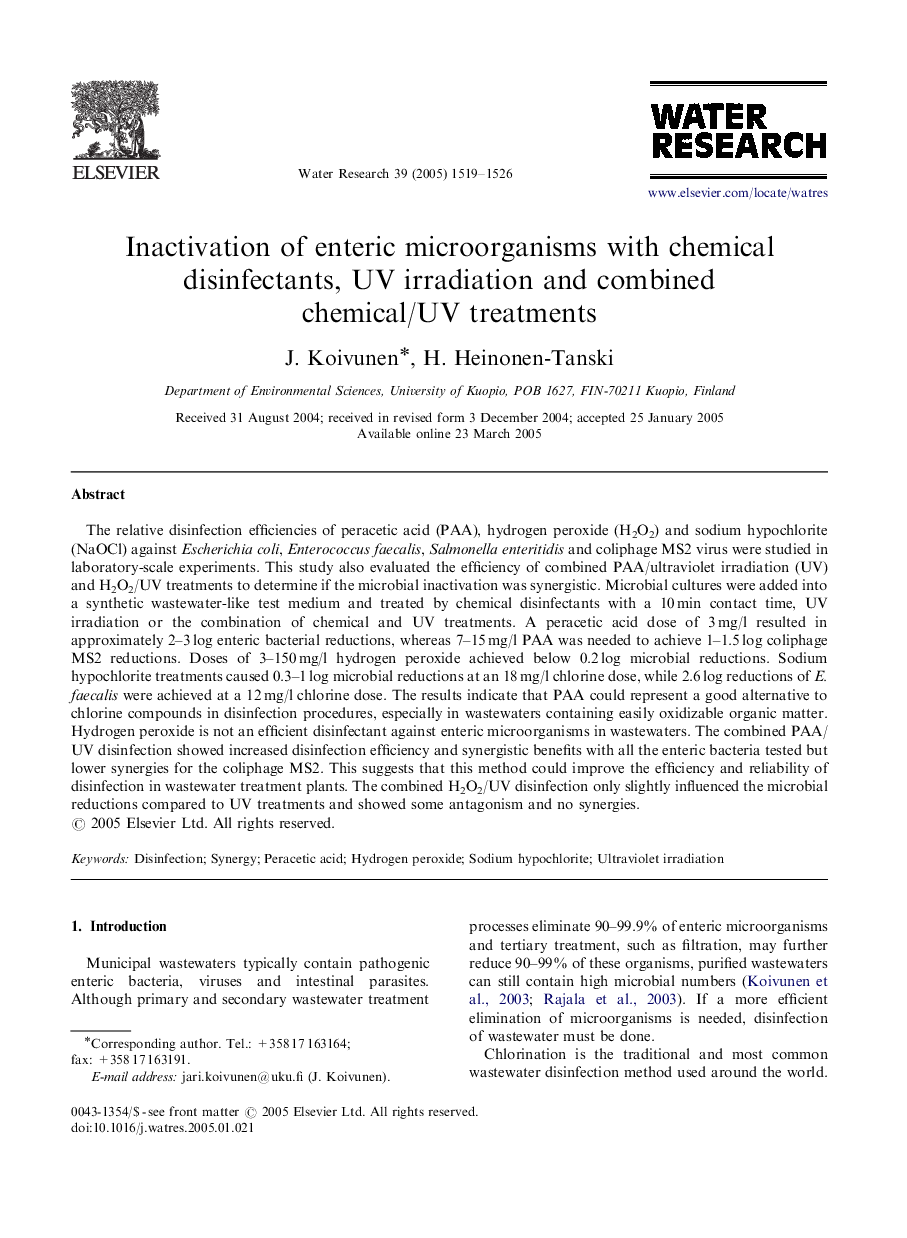| کد مقاله | کد نشریه | سال انتشار | مقاله انگلیسی | نسخه تمام متن |
|---|---|---|---|---|
| 9468200 | 1317007 | 2005 | 8 صفحه PDF | دانلود رایگان |
عنوان انگلیسی مقاله ISI
Inactivation of enteric microorganisms with chemical disinfectants, UV irradiation and combined chemical/UV treatments
دانلود مقاله + سفارش ترجمه
دانلود مقاله ISI انگلیسی
رایگان برای ایرانیان
کلمات کلیدی
موضوعات مرتبط
مهندسی و علوم پایه
علوم زمین و سیارات
فرآیندهای سطح زمین
پیش نمایش صفحه اول مقاله

چکیده انگلیسی
The relative disinfection efficiencies of peracetic acid (PAA), hydrogen peroxide (H2O2) and sodium hypochlorite (NaOCl) against Escherichia coli, Enterococcus faecalis, Salmonella enteritidis and coliphage MS2 virus were studied in laboratory-scale experiments. This study also evaluated the efficiency of combined PAA/ultraviolet irradiation (UV) and H2O2/UV treatments to determine if the microbial inactivation was synergistic. Microbial cultures were added into a synthetic wastewater-like test medium and treated by chemical disinfectants with a 10Â min contact time, UV irradiation or the combination of chemical and UV treatments. A peracetic acid dose of 3Â mg/l resulted in approximately 2-3Â log enteric bacterial reductions, whereas 7-15Â mg/l PAA was needed to achieve 1-1.5Â log coliphage MS2 reductions. Doses of 3-150Â mg/l hydrogen peroxide achieved below 0.2Â log microbial reductions. Sodium hypochlorite treatments caused 0.3-1Â log microbial reductions at an 18Â mg/l chlorine dose, while 2.6Â log reductions of E. faecalis were achieved at a 12Â mg/l chlorine dose. The results indicate that PAA could represent a good alternative to chlorine compounds in disinfection procedures, especially in wastewaters containing easily oxidizable organic matter. Hydrogen peroxide is not an efficient disinfectant against enteric microorganisms in wastewaters. The combined PAA/UV disinfection showed increased disinfection efficiency and synergistic benefits with all the enteric bacteria tested but lower synergies for the coliphage MS2. This suggests that this method could improve the efficiency and reliability of disinfection in wastewater treatment plants. The combined H2O2/UV disinfection only slightly influenced the microbial reductions compared to UV treatments and showed some antagonism and no synergies.
ناشر
Database: Elsevier - ScienceDirect (ساینس دایرکت)
Journal: Water Research - Volume 39, Issue 8, April 2005, Pages 1519-1526
Journal: Water Research - Volume 39, Issue 8, April 2005, Pages 1519-1526
نویسندگان
J. Koivunen, H. Heinonen-Tanski,